British alpaca – spinning a sustainable British luxury yarn in natural fibre
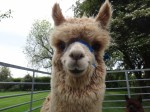 ‘What is alpaca yarn?’ ‘Why British alpaca?’ These are questions I’m regularly asked since setting up sustainable knitwear label, Ally Bee. Alpacas produce a fabulous soft fleece but there’s also strong environmental advantages to spinning a British alpaca yarn. So, to help answer ‘Why alpaca & why British’, here’s 12 curious facts about the creatures and their luxurious fleece:
‘What is alpaca yarn?’ ‘Why British alpaca?’ These are questions I’m regularly asked since setting up sustainable knitwear label, Ally Bee. Alpacas produce a fabulous soft fleece but there’s also strong environmental advantages to spinning a British alpaca yarn. So, to help answer ‘Why alpaca & why British’, here’s 12 curious facts about the creatures and their luxurious fleece:
1. Alpacas originate from the plateaus of the South American Andes and are the domesticated species of camelid resembling a llama, though smaller. Ancient Incas referred to alpaca as the ‘Fibre of the Gods’ because they produced a luxuriously soft and durable fibre. Today, along with cashmere, it is referred to as one of the ‘Noble Fibres’.
2. Today there are over 30,000 alpacas in the UK, mostly in small herds grazed non-intensively on open pasture on smallholdings (with shelters provided for rainy days). Alpacas in the UK are kept for hobby farms, or as pets, or to guard chickens against foxes, and increasingly they are kept for selective breeding to improve fleece and stock quality.
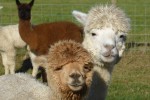 3. Alpacas are gentle and highly sociable creatures and must always be kept with at least one other alpaca because on their lonesome they become visibly distressed. To reassure their group, they hum gently to each other (this really is true!)
3. Alpacas are gentle and highly sociable creatures and must always be kept with at least one other alpaca because on their lonesome they become visibly distressed. To reassure their group, they hum gently to each other (this really is true!)
4. Benefitting from natural selection’s hardy genetics inherited from the harsh climes of the Andes – and a good dose of TLC – many alpacas in the UK produce high-grade fleeces on par with their Peruvian cousins. Some breeders have even claimed certain British alpaca fleece is surpassing the quality of the South American alpaca.
5. Alpaca are ‘ruminants’, which means they cut grass like a deer rather than ripping it out from the roots like a sheep or goat. They are nature’s perfect lawnmowers. And, they eat less than most other domesticated animals. British alpaca has some serious eco-credentials!
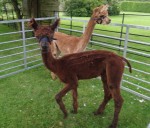 6. Alpacas produce a wonderfully thick fleece of up to 150mm, clipped every year. British alpaca shearing day is like an MOT – they get a hair-cut, toe-clip and eyebrow trim, a dose of vitamins and vaccinations. Alpacas are kept with the best care because this promotes a healthy rich fleece. Helping out on shearing day this year at Andante Alpacas in Buckinghamshire, I witnessed the care and dedication of an alpaca shearer shearing 30 alpacas in a day – tough work – making barely a single nip on this much loved herd. I’ve heard some farmers even bring out the aromatherapy candles on shearing day to reassure their animals …
6. Alpacas produce a wonderfully thick fleece of up to 150mm, clipped every year. British alpaca shearing day is like an MOT – they get a hair-cut, toe-clip and eyebrow trim, a dose of vitamins and vaccinations. Alpacas are kept with the best care because this promotes a healthy rich fleece. Helping out on shearing day this year at Andante Alpacas in Buckinghamshire, I witnessed the care and dedication of an alpaca shearer shearing 30 alpacas in a day – tough work – making barely a single nip on this much loved herd. I’ve heard some farmers even bring out the aromatherapy candles on shearing day to reassure their animals …
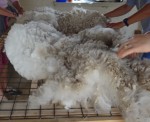 7. Nothing need go to waste from the annual alpaca clip. Alpaca fleece is graded by hand, divided into the ‘firsts’ from the saddle region – best for spinning into yarn for knitting or wovens – and the lesser grade ‘seconds’ and ‘thirds’ from the neck and legs are perfect for insulation. Or, duvet filler for ingenious PenroseProducts who buy up low grade fleece from alpaca farmers to make luxurious and sustainable alpaca duvets.
7. Nothing need go to waste from the annual alpaca clip. Alpaca fleece is graded by hand, divided into the ‘firsts’ from the saddle region – best for spinning into yarn for knitting or wovens – and the lesser grade ‘seconds’ and ‘thirds’ from the neck and legs are perfect for insulation. Or, duvet filler for ingenious PenroseProducts who buy up low grade fleece from alpaca farmers to make luxurious and sustainable alpaca duvets.
8. Alpaca fibre has a smoother scale surface than wool, creating a special softness and shine. But, bringing out the very best in alpaca fibre requires skilled sorting and a trained eye on the spinning process – and a large dose of patience. The journey from the raw fibre, to the finished yarn, is certainly not a ‘fast fashion’ pursuit.
9. Alpacas produce fleece with a colour palatte of 22 possible shades – in assorted browns, creams, and near-black. Colours can be blended further to create an even wider choice of shades, all without the need for the chemical and high water consumption of the colour dyeing process.
10. Unlike sheep’s fleece fibre, alpaca has a hollow core and is light weight. The unique hollow fibre contracts in the winter for warmth – and is considered warmer than wool – and expands in the heat for a cooler drape.
11. Alpaca does not contain lanolin and can be washed in the spinning process without the use of heavy detergents required for cleaning greasy wool. Being lanolin free, alpaca is hypoallergenic.
12. At the end of its wearing life, an undyed alpaca garment can be returned to the earth to biodegrade without leaching chemicals, and because it is made of protein the fibre will break down much faster than synthetics.
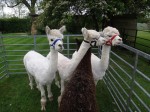 So, the reasons for choosing British alpaca – from style and sustainability angles – are abundant. British alpaca certainly ticks a lot of boxes – from high standards of animal welfare, to a low environmental footprint. The growing and evolving stock of alpacas in the UK makes it possible to source a luxurious British grown natural fibre that can be spun into a yarn that is durable, annually renewable and incredibly soft. Over the past two decades the British wool industry has been brought to its knees by market shifts towards imported fleece. The natural fibre yarns market is dominated by cashmere from Mongolia and China, Merino and lambswool from Australia and New Zealand and, to a lesser extent, alpaca from Peru. Conventional fashion wisdom says yarns in high-end fashion must be supplied from an on-demand stock service, invariably made from these fleeces sourced abroad. Yet with 30 000 alpacas quietly grazing on British pasture, perhaps it is time to spin a new yarn about what might be fashionably possible
So, the reasons for choosing British alpaca – from style and sustainability angles – are abundant. British alpaca certainly ticks a lot of boxes – from high standards of animal welfare, to a low environmental footprint. The growing and evolving stock of alpacas in the UK makes it possible to source a luxurious British grown natural fibre that can be spun into a yarn that is durable, annually renewable and incredibly soft. Over the past two decades the British wool industry has been brought to its knees by market shifts towards imported fleece. The natural fibre yarns market is dominated by cashmere from Mongolia and China, Merino and lambswool from Australia and New Zealand and, to a lesser extent, alpaca from Peru. Conventional fashion wisdom says yarns in high-end fashion must be supplied from an on-demand stock service, invariably made from these fleeces sourced abroad. Yet with 30 000 alpacas quietly grazing on British pasture, perhaps it is time to spin a new yarn about what might be fashionably possible
Alison Baker is the Founder of all-British knitwear label, Ally Bee. See ally-bee.com
Ally Bee is at the East London Design Show at the Truman Brewery, London 4-7 December 14.
Copyright Alison Baker 2014
Photos taken at Andante Alpacas in Buckinghamshire.
Women
A wide selection of stylish fashion clothing for all occasions including: dresses, tops, knitwear, skirts, eveningwear, coats, suits, jackets and more. Styles to suit a variety of tastes from classic to vintage and more in between: recycled and upcycled. This is sustainable ethical fashion at it's best.
Women's Ethical ClothingMen
If you're looking for something eco or ethical to wear for dress down friday, a casual weekend or holiday, you'll find it here. Tops, t-shirts, jeans, trousers from mainly fairtrade and organic cotton.
Men's Ethical FashionKids
Green fashion for kids is fun and made mainly from natural fibres including organic cotton and Fairtrade cotton. From baby to early teens, there's something to make all kids happy. Bright colours, animals, fun shapes that children can wear all year round.
Kids Green ClothingAccessories
A treasure trove of accessories from around the world can be found here. A vast selection of jewellery including necklaces, bracelets, rings and earrings to shoes, hats, bags, handbags and scarves. Whatever your style, these items will complete any outfit.
Eco-Friendly Accessories




Comments are closed.